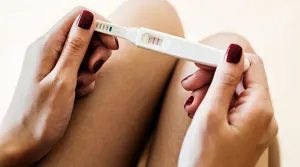Due Date Calculator
So you’ve found out you’re pregnant—congrats! For many moms-to-be, the next question on their minds is “When am I due?” or “How far along am I?” But accurately calculating your pregnancy due date isn’t quite as simple as plotting a nine month forecast (in fact, pregnancy is typically 40 weeks long, which is more than nine months!). Your doctor will give you your official due date after your first prenatal visit, but when you just gotta know baby’s birthday now(!), count down to the big day with The Bump due date calculator.
If you conceived through in vitro fertilization (IVF), the pregnancy due date calculator may not be the right method for you. If you fall into that bucket, see below for how to calculate your due date for an IVF pregnancy.
Using The Bump Due Date Calculator
Know the first day of your last menstrual period (LMP)? Enter the date into the calendar tool, and voila your due date will appear. Of course, keep in mind that this is based on a typical 28-day cycle—and not every woman has a 28-day cycle or ovulates exactly mid-cycle.
How to Calculate Due Date By Conception
You’re likely trying to answer the burning question, “When is my due date?” If you happen to know the exact day you conceived, you could calculate baby’s due date by counting 38 weeks from the date of conception (38 weeks is said to be the length of human gestation), says Cleveland Clinic. But figuring out an accurate due date based on conception date is easier said than done: Unless you were really deliberate about tracking your ovulation or were able to make a baby in one shot (and had no extracurricular fun otherwise), knowing which day was the big one isn’t clear-cut. Even if you had sex only once during your six-day fertile period, you may not have actually conceived that day unless you happened to be ovulating.
Conception happens when sperm and egg join, after which an egg is fertilized, but since sperm can live inside your fallopian tubes for up to five days waiting for an egg to be released, you could conceive up to five days after having sex. It’s enough to make your head spin. That’s where The Bump due date calculator, or a pregnancy calculator, helps.
How to Calculate Due Date Based on Last Period
Still wondering “How far along am I?” The most common way of determining when baby will be born is to calculate baby’s due date based on your last menstrual period, which is how a pregnancy calculator works. If you have an average-length cycle (about 28 days), your period came about two weeks before you ovulated and conceived. To arrive at your baby due date, count forward 40 weeks (that’s the 38-week gestation plus two weeks) from the first day of your last period and mark a big X on your calendar for Baby Day! Again, you can also try plugging the start date of your last menstrual period into The Bump pregnancy due date calculator above to get instant results. Remember, while a 28-day cycle is considered the norm, it can vary—and not everyone ovulates exactly mid-cycle. (Additionally, not everyone will remember with perfect precision the first day of their last period). Another (more accurate) way to calculate your pregnancy due date is by ultrasound (see below).
How to Calculate Due Date By Ultrasound
Other than using a due date calculator based on your LMP, your doctor can also calculate your pregnancy due date by ultrasound, especially if you have an irregular cycle. When you go in to see your OB or midwife for your first prenatal appointment, they’ll likely schedule you for an ultrasound to confirm the pregnancy. During the ultrasound, the technician or physician will measure baby’s length, from crown to rump, to gauge how far along you are and calculate your due date. According to the American Academy of Obstetricians and Gynecologists (ACOG), a first-trimester ultrasound is the most accurate method to establish or confirm gestational age. If baby is much bigger or smaller than expected for the gestational age based on your LMP, your doctor may change your due date based on what they see on the first-trimester ultrasound.
How to Calculate IVF Due Date
If you underwent in vitro fertilization, you have the benefit of knowing exactly when the egg was fertilized, so an IVF due date calculator can be very precise. Plus, you don’t have to worry about any changes to baby’s anticipated date of arrival as you might with a pregnancy calculator based on LMP. (Whether baby is actually born on that day is of course another story.) Your baby due date is determined by either when you ovulate—meaning your egg retrieval or intrauterine insemination (IUI) day—or whether you’re having a three- or five-day embryo transfer. For a day three embryo, count forward 263 days from the transfer for your due date; for a day five embryo, add 261 days.
How to Calculate Due Date for Twins
If you naturally conceived twins or multiples and haven’t already been told your pregnancy due date by your doctor, you can use The Bump due date calculator above based on your LMP, just as you would if you weren’t doubling (or tripling) down on babies. How to calculate due date for multiples is the same method you’d use for a singleton baby, but keep in mind that delivery day recommendations may change: For example, dichorionic diamniotic twins (where each twin has a separate placenta and amniotic sac are usually delivered early. So just know that twins may arrive earlier than the due date noted by the pregnancy calculator. A first-trimester ultrasound is the most accurate way to calculate due date, and changes to the date after that measurement is done are extremely rare.
Now that you can confidently answer “When am I due?,” you can also get the scoop (just for fun) on if your wee one will supposedly be a boy or a girl. Use the Chinese gender chart to predict baby's sex while you wait for the official (and more reliably accurate) ultrasound or prenatal testing results.
Please note: The Bump and the materials and information it contains are not intended to, and do not constitute, medical or other health advice or diagnosis and should not be used as such. You should always consult with a qualified physician or health professional about your specific circumstances.
American Academy of Obstetricians and Gynecologists, How Long Does Pregnancy Last?, November 2023
Cleveland Clinic, Due Date Calculator, October 2021
US Department of Health and Human Services Office on Women’s Health, Ovulation Calculator, February 2021
Cleveland Clinic, Conception, September 2022
American Academy of Obstetricians and Gynecologists, Methods for Estimating the Due Date, May 2017
Columbia University Department of Obstetrics and Gynecology, Dichorionic Twins
StatPearls, Multiple Birth Delivery, January 2024
Learn how we ensure the accuracy of our content through our editorial and medical review process.































